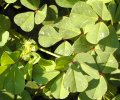
Murex medic

Murex medic
(High-resolution
image available)
NOTE: The information in this Agnote must be read in conjunction with Introduction to selecting and using pastures in NSW, which covers information on areas of adaptation, sources of variability, species mixtures, and important issues related to animal health and the conservation of native vegetation.
| Pasture type and use | Winter-growing annual legume. Dryland grazing, hay production, legume break crop and crop rotation. |
|---|---|
| Area of adaptation | Mainly in the Central West and South West Slopes, and Southern Tablelands. |
| Min. average annual rainfall | 500 mm (southern NSW) |
| Advantages |
|
| Disadvantages |
|
| Soil requirements | Grows on a range of soil types from red-brown earths to cracking clays. Will grow on acid soils if correct inoculum used. Not for pH < 4.5(Ca) and >15% soil aluminium. |
| Varieties | Zodiac |
| Sowing rates: | |
| - as only species | 3–6 kg/ha |
| - in mixtures | 2 kg/ha |
| Sowing time | Autumn for all districts. |
| Companion species | Sub clover, lucerne (winter-active). Also suitable for sowing with a low rate of oats (e.g. 10 kg/ha) as a high-yielding forage legume break crop. |
| Inoculation | Medic (or group AM). |
| Major nutrient deficiencies | Usually phosphorus, sulfur in some areas, occasionally zinc and molybdenum. |
| Main insect pests | Redlegged earth mite, blue oat mite, lucerne flea, spotted alfalfa aphid, bluegreen aphid, pea aphid. |
| Main diseases | Crown rot, root rot, alfalfa mosaic virus, phoma. |
| Management | Once established can be continuously grazed. Avoid overgrazing at seed-set in initial year to build seed reserves. Incorporation of pods with light discing after seed-set protects pods from being eaten by sheep and improves regeneration. Cropping after the first year is an alternative method to burying pods, and ensures good regeneration. |
| Livestock disorders of particular note | Photosensitisation in horses; occasionally red gut in sheep; frequently bloat in cattle. |
| Additional tips | Sowing without a cover crop greatly improves establishment. |
| Further information |
|
Acknowledgment
Advice on livestock health disorders was provided by Dr Chris Bourke, Principal Research Scientist, NSW Agriculture, Orange. His contribution is gratefully acknowledged.
Photo: Warren McDonald, Former Technical Specialist (Pastures), NSW Agriculture, Tamworth.

